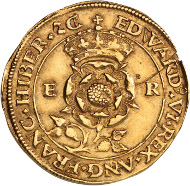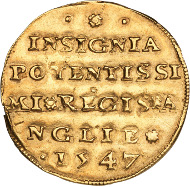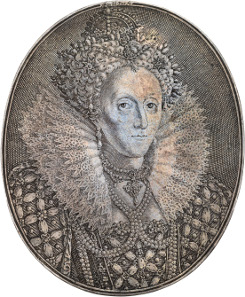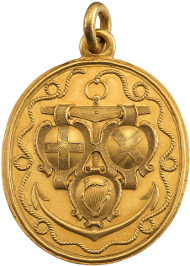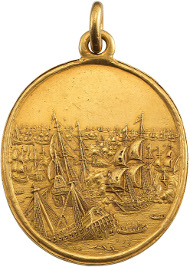15-10-2014 – 01-01-1970
The Christopher Foley, F.S.A., Collection Of Early English Medals
The Christopher Foley, F.S.A., Collection Of Early English Medals
A private medal collection assembled over the last quarter of a century or so by Christopher Foley, F.S.A., a long-established dealer in early English paintings and director of Lane Fine Art Limited, was sold at Woolley & Wallis Salisbury Salerooms on October 16th.
With nearly 600 lots of British medals of the 15th – 17th centuries such a dispersal is exceedingly rare.
His first medal was bought as little more than a souvenir of a successful sale of the famous George Gower ‘Sieve’ portrait of the Queen, the rare oval uniface portrait medal of Elizabeth I started what has been described as a collection that ‘has perhaps never been equalled and certainly never surpassed in more than 100 years.’
Lot 14 – Edward VI, Coronation 1547, a coin-like gold medal. Sold for £36,000. Prices quoted are hammer price plus buyers premium.
Encouraged by the egregious advice of Richard Falkiner, F.S.A., Christopher Foley soon developed a taste for (not to mention a large collection of) early British medals. His personal preference was for the hammered and the hand-made, so in the early years the collection concentrated on the era from the medallic incunabula of the Tudors to the relative sophistication of the Commonwealth era. The later 17th century machine-struck medals followed in more recent years.
The occurrence of a sale such as this, is one that can be measured on a century by century basis. The most recent comparable, but less comprehensive, named sale, was that of the Greta S. Heckett collection at Sotheby’s in 1977. A sale by Morton and Eden in May 2003 was, like now, the collection of a London dealer buying outside his business disciplines. Glendining’s held the sale of the “English Collector” in March 1989 which, to the end of the reign of William III, was a little over 400 lots. Sotheby’s, six days earlier, had held an anonymous sale of English medals, and further items from the same collection appeared at Bonhams in March 1998 as the “Papillon Collection”. Spink’s, then new to auctions, held a big sale of British historical medals in February 1980. The R.W. Cocheran-Patrick sale of 1949 only offered 129 lots, lots relating exclusively to Scotland. The collection of Helen Farquhar, who wrote so much about the medals, badges and portraiture of the period covered by the present sale, was another modest offering of just over 100 lots – though many treasures were hiding in multiple groups.
Estimates ranged from £20 – £40,000. A busy view over two days during London’s Coinex and viewing in Salisbury combined with considerable coverage from coin and medal publications gave enthusiasts the opportunity to see the entire collection and drew buyers in from all over the world.
Lot 127 – Elizabeth I, silver oval portrait medal by Simon de Passe, circa 1616. Sold for £16,500. Prices quoted are hammer price plus buyers premium.
The sale included no fewer than 10 of the oval portrait medals by Simon de Passe (c. 1574-c.1644), the youngest son of Crispin Passe, an eminent artist from Utrecht, who taught him the art of engraving. De Passe came to England in about 1613, living here some 10 years mostly in the employment of Nicholas Hillard to engrave counters of the Royal Family of England. In later life he moved to the service of the King of Denmark. The medals made by some long-lost process that makes them seem as if they were engraved.
The first of the de Passe lots was lot 127, Elizabeth I, circa 1616, which was keenly contested in the room and online, exceeding the upper estimate, selling for £16,500, another of James I, Queen Anne, and Prince Charles, an oval silver portrait medal sold for £17,100, to the same American collector.
Lot 366 – The Naval Reward for Captains, a gold medal, 1653. Sold for £44,000.
Undoubtedly the highlight of the £583,000 sale was lot 366, The Naval Reward for Captains, a gold medal, 1653, by Thomas Simon, estimated at £30,000 – £40,000 this example is only the fourth to have appeared at public auction since the War, although about 80 are thought to have been made. Bidding quickly gathered pace with phone bidders, internet interest and buyers in the room all keen to purchase this ‘extremely fine and excessively rare, superb gold medal.’ Bought through the internet on behalf of a client by the English trade, the lot sold for £44,000.
Coin and medal expert Richard Falkiner, F.S.A., commented ‘The excellent catalogue was compiled by savant Daniel Fearon who has a life time’s experience in this type of material and the catalogue shall make weary the shelves of the cognoscenti.’ He went on to say ‘the best (highest priced) and rarest but not necessarily the most aesthetically pleasing went very well indeed.’
For enquiries please contact Lucy Chalmers by phone (+44 (0) 1722 424594) or by email.
All results can be found on the website of the auctioneers.





